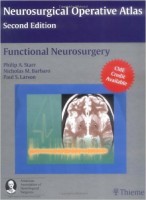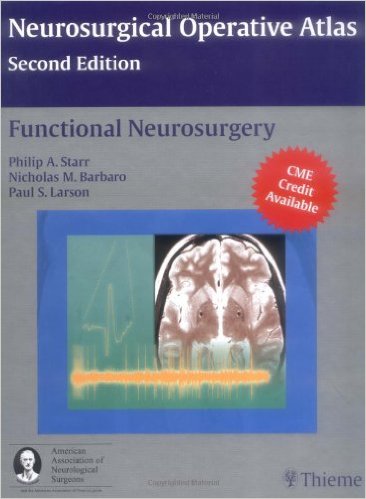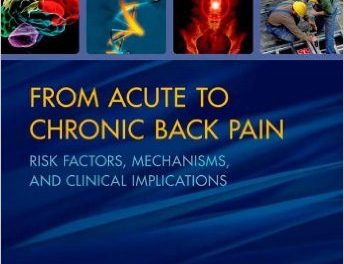 (Part of a series of five volumes. The others are: Neuro-Oncology, Spine and Peripheral Nerves, Pediatric Neurosurgery, and Vascular Neurosurgery).
(Part of a series of five volumes. The others are: Neuro-Oncology, Spine and Peripheral Nerves, Pediatric Neurosurgery, and Vascular Neurosurgery).
Editors: Philip A. Starr, MD; Nicholas M. Barbaro, MD; and Paul S. Larson, MD
Publisher: Thieme – 284 pages
Book Review by: Nano Khilnani
This textbook was published in joint cooperation between Thieme Medical Publishers and the American Association of Neurological Surgeons (AANS). It offers a Continuing Medical Education (CME) credit to those who complete the requirements listed on page viii of this book.
The first edition of this book was published in 1991, and much knowledge has been acquired since then which is incorporated in the current second edition. Functional neurosurgery is the subspecialty that has, and is benefitting, from the most rapid introduction of novel procedures. (The other subspecialty of neurosurgery is vascular neurosurgery).
Eighty contributors including the editors, mostly from the United States, but also from six other countries – Canada, Germany, Greece, Israel, Italy, and the United Kingdom – wrote the 40 chapters of this book. They are practitioners and professors of neurology and neurosurgery including spine surgery, as well as other fields such as anesthesiology, biomedical engineering, psychiatry, and radiology.
Too numerous to list the 40 chapters of this text here, we provide you below the names of the four sections around which the chapters are organized:
- Epilepsy: 11 chapters
- Pain: 15 chapters
- Movement Disorders: 11 chapters
- Other Disorders: 3 chapters
In this book, the aspiring or currently practicing neurosurgeon can benefit from learning concise descriptions of existing and new indications, details of surgical approaches and techniques, and perioperative complications for the major procedures in functional neurosurgery. You will note above that the chapters have been grouped around the three major branches in this medical subspecialty: epilepsy, pain, and movement disorders.
You will also find that physiological principles and state-of-the-art recording techniques used for brain localization are well explained and illustrated. For a number of surgical procedures, multiple technical approaches are explained.
This second edition contains the following new material:
- Brain stimulation indications
- “Frameless” neuronavigation approaches to deep brain targets
- Use of interventional magnetic resonance imaging (MRI)
Most of the chapters in this text are short, but succinct. With 40 chapters in a book of just 264 pages not counting the Index, the average chapter length works out to less than seven pages. Some are shorter such as chapter 9 – Multiple Subpial Transection – which is only 4 pages long. One of the longer ones is chapter 3 –Surgical Anatomy of the Temporal Lobe – that has 14 pages of material. It also has a lot of images: 42 in total.
So when we look at the structure of most chapters, we find that they pretty much follow the organizational scheme the editors have formulated for this book, having the following components:
- Chapter Title and Bylines
- Introduction, or a few introductory paragraphs on the coverage area of the chapter
- Patient Selection (who, why and how he/she is to be chosen)
- Preoperative Preparation (anatomy, anesthesia, etc.)
- Operative Procedure (with subtopics relevant to the particular procedure)
- Postoperative Management Including Possible Complications
This atlas is an excellent guide with innovative but effective surgical techniques for treating epilepsy, pain, and movement disorders. It contains detailed descriptions of various conditions and diseases. It provides clear and concise language on various procedures and treatment options, and is well illustrated with numerous images. In each chapter, you have guidance on patient selection, preoperative preparation, operative procedure, and postoperative management, including complications. And conclusions.
Editors:
Philip A. Starr, MD is Associate Professor in the Department of Neurological Surgery at the University of California, San Francisco School of Medicine in San Francisco, California.
Nicholas M. Barbaro, MD is Professor in the Department of Neurological Surgery at the University of California, San Francisco School of Medicine; and Co-director of the Division of Neurological Disorders at University of California, San Francisco Medical Center.
Paul S. Larson, MD is Assistant Clinical Professor in the in the Department of Neurological Surgery at the University of California, San Francisco School of Medicine; and Attending Surgeon at San Francisco Veterans Affairs Hospital and Medical Center in San Francisco, California.







